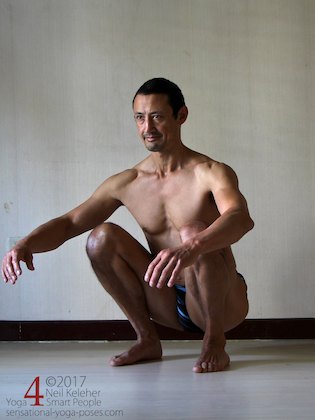Body Weight Squat
Some Body Awareness Tips for Working Towards It
Kids often naturally squat to get close to the ground. Some squats are referred to as cossack squats, they actually dance from this position. Just being able to squat comfortably may be a good indicator that you are in pretty good shape, but it could also mean that, assuming you can stand up from this position and lower down into it easily and with control, that you'll have less problem getting up from a seated position which can be a good ability to maintain as you get older.
Are Squats Safe?
So are squats safe? It depends on how you do them. The parts it affects most extremely are the knees and hips, but it can also affect (and be affected by) the ankles and feet, the si joint and the lower back.
So how do you make squats safe, how do you learn to squat safely?
Learning the Body Weight Squat Safely
I'd say the most important thing is learning to feel your knees and hips, and the muscles that work on them. And also learning to control them. And actually the process of working towards the squat could be though of as simply the process of maintaining awareness and control of these joints and muscles in new positions (those positions being the ones that you use to move towards a full squat.)
Ligaments are Active Structures
One of the underlaying assumptions of this article (and website) is that ligaments are active structures. They are affected by muscle tension. In turn joint capsules, via ligaments, are affected by muscle tension. And so part of feeling and controlling the hips and knees is learning to operate the muscles that work on them in such a way that the joint capsules maintain integrity.
A good indication of failure in this regard is joint pain. And so learning to squat intelligently means figuring out ways to squat, by varying muscle tension, so that your joints don't hurt.
Redefining Stability
In terms of stability, we tend to (or I tend to at least) think of stability as something that doesn't move. So for example, making the lower body stable gives the upper body, the torso and the arms, a foundation from which to move from.
Stable parts of the body are ideally still.
So now we have to redefine stability, make the definition a bit more flexible.
One way of creating stability in the body is to use opposing muscles against each other. With the former definition, these muscles exert enough force to balance each other and keep the joint(s) they are working on still.
But what if you varied tension in one or both muscles so that they kept working against each other but allowed or created movement at the same time.
You could think of this as adjustable stability.
Squats are a Little Like the Splits
Squats is a bit like splits in this regard.
The muscle that you are stretching, or changing is the same muscle that is supporting you.
In the case of the squat the muscles that work on the knees and hips are the muscles that both stabilize these joints, resisting the weight of the body, but that also help to control the descent of the body to the bottom position.
Doing splits, once your pelvis touches the floor you don't need muscular stability. You can turn your legs muscles off if you like and do a relaxed stretch, or keep them active extra strengthening effect.
Likewise in squat, once you get to the bottom you can relax if you choose. Or you can keep your legs active.
If you are new to squatting the idea would be to try to gradually relax at the bottom. If pain occurs, then stop relaxing.
If you are working towards being able to relax in the squat, then how do you work towards that if there's pain? It may be that you need some muscle activation. For myself I find activating the calves and the backs of the knees often helps.
But I might also vary foot and knee position, or the tilt of the pelvis.
Activating the feet in different ways is another technique. Perhaps stabilizing the heels and back of the ankles will be helpful.
Here's a bit more on how to work towards the deep squat.
Published: 2017 03 23
Updated: 2021 01 28



